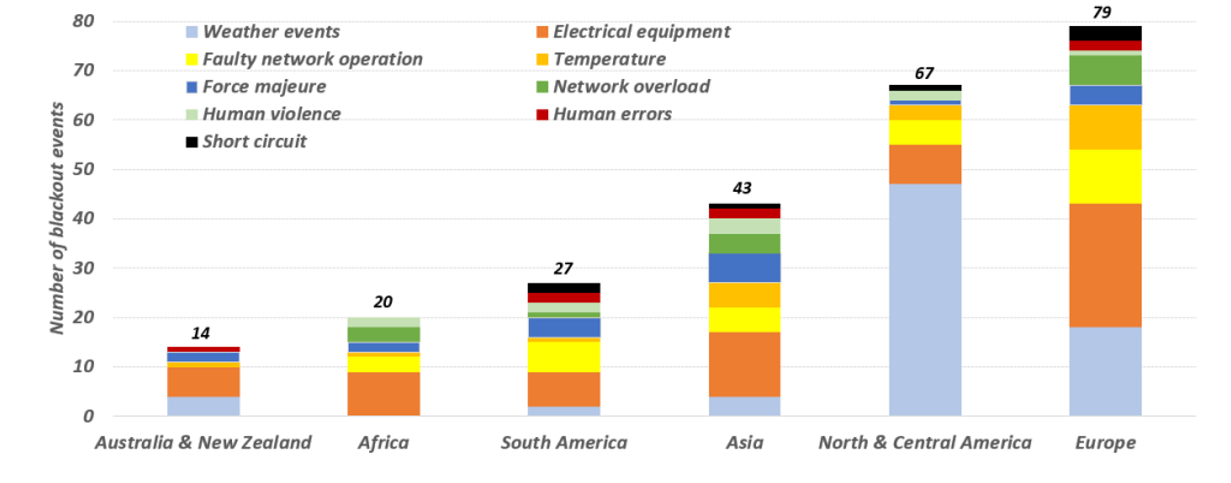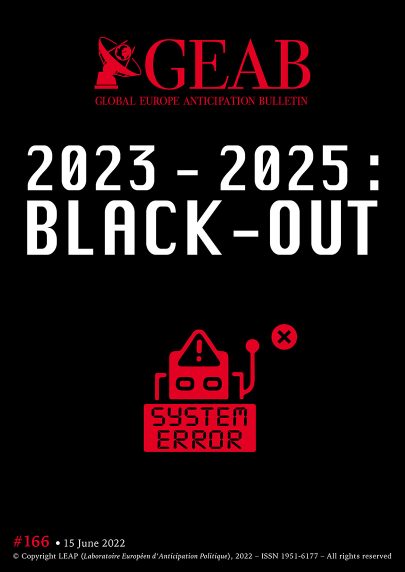GEAB 166
Article written by Christopher H. CORDEY, Swiss national, founder of Futuratinow, a consulting firm specialising in IDEAtion, strategic anticipation and training. Partner of Yonders.world.
Denial, illusion of security, feeling of powerlessness and unpreparedness seem to prevail in terms of preparing the population for the risk of a blackout on a European scale. Blackout is a frightening term, still somewhat taboo in certain chancelleries, whereas the American, Austrian and Swiss governments – among others[1] – have been mobilising their populations to prepare for it for years. Prosilience[2] is becoming a national security issue.
Perspectives
At the end of a cold day in 2022, the European power grid begins to fail. Blackout. Many countries – whose governments were already struggling to deal with hybrid threats, the emergence of yet another pandemic and the socio-geopolitical and economic impact of the war in Ukraine – are plunging into darkness. Several nuclear power plants are endangering the lives of millions of Europeans. Wind turbines are at a standstill for lack of wind. Stunned commuters lined the railways. The rush to the cash machines and petrol stations is futile. So is the use of mobile phones. Panic. Terrorist act, lightning, cold wave, electromagnetic bomb, cyber attack, solar storm, network overload or simple technical failure? It doesn’t matter for the moment; the result is the same. Chaos, shortages, riots and looting are likely to be the new normal if the power is not quickly restored. Some governments, more pro-active than others, are silently congratulating themselves. But for how long? The cost of the black-start[3] will be phenomenal[4].
Electricity, our greatest dependency
Our dependency on electricity is total. Without it, life as we know it would come to an end as it is at the heart of almost every aspect of our modern lives. It powers our computers, tablets, laptops, fire detectors, heat pumps, air conditioners, refrigerators, fans or respirators, but also water purification, waste treatment, logistics and communication systems. We are so vulnerable.
But in the future, electricity supply will become increasingly precarious due to peak oil, political instability, neglected infrastructure maintenance, new vulnerabilities arising from increased connectivity (IoT)[5], global warming and the shift to renewable energy resources. Demand, in turn, will increase due to population growth, rising wealth levels and the accompanying dependence on consumption[6]. As a result, power outages will become more frequent and severe with increasing demand coupled with system complexity.

Figure 1 – Different causes of blackouts from past events classified by continent. Source: ProofreadP
The risk of blackout
Unlike a power cut, a momentary and localised interruption of electricity supply, or even an electricity shortage, a predictable event due to a lack of available electricity, a blackout[7] is the interruption of the electricity supply of a region or country. It is a sudden, unpredictable phenomenon that is relatively unknown to the general public but feared by specialists[8]. The consequences of such an interruption vary depending on the area affected, the duration of the interruption and the resilience of the affected area[9].
The causes of a blackout are threefold and can be combined:
. natural disasters (floods, snow, heat waves, ice storms, wind and solar storms, pandemics, etc.). In January 2005, a violent storm swept through Northern Europe, from Ireland to Russia. More than 500,000 homes were left without power, with Denmark and southern Sweden particularly hit. And five nuclear power plants were shut down due to saltwater seeping into the power distribution plants.
. technical disasters (grid overload, explosions, industrial accidents, nuclear accidents, technical and IT problems, etc.). At the end of April 2022, a record heat wave[10] hit India and Pakistan (maximum value of 62°C), which experts link to climate change[11]; the network was overloaded, causing major power cuts.
. man-made threats (sabotage, terrorist or cyber attacks,[12] human error, malicious acts, electromagnetic bombs, etc.). In December 2015, the BlackEnergy (BE) malware, discovered on Ukrainian critical infrastructure networks, caused power outages on the Ukrainian electricity grid.[13]

Figure 2 – Causes and consequences of significant blackouts. Source: Econstor, 2018
Catastrophic and dizzying consequences Login

The tangle of all the crises in the making is reaching such an intensity that it is hard to believe that a major rupture will not occur by the end [...]
The Ukrainian crisis is currently allowing many countries to advance their pawns. Turkey, in partnership with Israel and at the forefront of these actors, is inventing the future of the [...]
BRICS + While the European continent seems to be living in tune with the delivery of arms to Ukraine and the political shockwaves caused by the conflict in our societies, [...]
Gold, Bitcoin: Focus on traditional investments // Yen, the first pawn to fall? // End of combustion engines in 2035 // Oil: The rise continues Gold, Bitcoin: Focus on traditional [...]

Comments